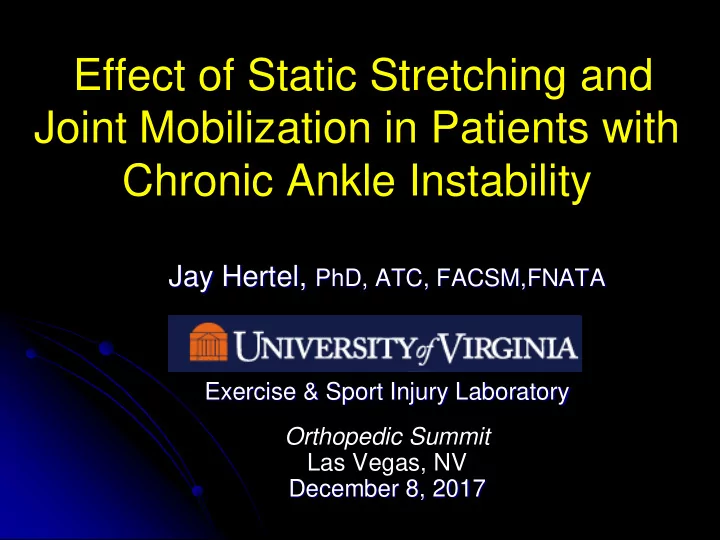

Effect of Static Stretching and Joint Mobilization in Patients with Chronic Ankle Instability Jay Hertel, PhD, ATC, FACSM,FNATA Exercise & Sport Injury Laboratory Orthopedic Summit Las Vegas, NV December 8, 2017
Disclosures Textbook Royalties – Wolters Kluwer Grant Support: National Institutes of Health
Ankle Sprains: Public Heath Issue Ankle sprains are the most common injury in sports Also common in military personnel & the general population Societal burden includes direct costs, indirect costs, & long term consequences Gribble et al, Br J Sports Med, 2016
Ankle Sprains as a Public Heath Issue Chronic ankle instability (CAI) Repetitive sprains and “giving way” Persistent symptoms Diminished self-reported function Prevalence = 40% of 1 st time sprainers at 12 month follow-up (Dohertry et al, AJSM, 2016) College students with CAI take ~2000 less steps per day than their healthy counterparts ( Hubbard et al, JAT, 2015) Relationship between ankle sprain history and development of osteoarthritis ( Valderrabano et al, AJSM, 2006 )
Hertel & Corbett (in press)
Donovan & Hertel, Chronic Ankle Instability Physician & Sports Med, Assessment & Treatment Algorithm 2012 Assess ROM Treat ROM Re-assess ROM Assess Strength Treat Strength Re-assess Strength Assess Balance Treat Balance Re-assess Balance Assess Treat Functional Re-assess Functional Activities Functional Activities Activities
Donovan & Hertel, Physician & Sports Med, 2012 ROM Treatment Treat with Mobilizations and Stretching Assess ROM Arthrokinematic Deficit No Re-assess ROM Osteokinematic Deficit Treat with Stretching
Joint Motion Algorithm Physiological Movement (Osteokinematics) Hypomobile Hypermobile Normal Strengthening & Neuromuscular Accessory Movement Control Exercises (Arthrokinematics) Limited = Capsular Restriction Evaluate at each relevant joint & Grade III/IV/V Mobs assess functional movement of the Normal = Contractile Restriction lower extremity Stretch Contractile Tissue
Osteokinematic Assessment
STRETCHING WORKS, BUT… Stretching of the triceps surae muscles results in increased ankle dorsiflexion ROM, but it is unlikely to address arthrokinematic restrictions
Joint Mobilizations: Indications & Contraindications Contraindications: Indications: Hypermobility Pain Joint effusion (Grade I-II OK) Joint Intra-articular fixation hypomobility Osteoporosis Muscle inhibition Healing fracture Malignancy in spine or limb Osteomyelitis Rheumatoid Arthritis
Talocrural Distraction Grades I-II: Pain relief Grades III-V: Increase general motion No research on isolated use of this technque
Anterior-Posterior Talar Glides Talus must glide posteriorly on tibia during ankle dorsiflexion By far, the most researched joint mobilization concept at the ankle Dorsiflexion deficits commonly reported after ankle sprain – WHY?
RESTRICTED POSTERIOR TALAR GLIDE Posterior talar glide restricted 12 weeks after ankle sprain (Denegar et al, JOSPT, 2002) Patients treated with posterior talar mobilization regained dorsiflexion ROM quicker after acute sprain 7° more dorsiflexion after 3 treatment sessions (Green et al, Phys Ther., 2001) Patients with CAI treated with posterior talar mobilization had immediate increases in: Dorsiflexion ROM (26%) Posterior talar glide (50%) (Vicenzino et al, JOSPT, 2006)
Anterior-to-Posterior Talar Glide
J Orthop Res . 2012 During each session, each subject received 2, 2-min sets of Maitland Grade II talocrural joint traction and 4, 2-min sets of Maitland Grade III talocrural joint mobilization with 1 min of rest between sets.
Direct comparison of talocrural joint mobilizations, calf stretching, & plantar massage
Tibiofibular Joints Distal fibula is “stuck” Tibia anteriorly and inferiorly Proximal fibula stuck posteriorly (Mulligan) Mounting evidence supports this phenomenon in some Talus patients with lateral ankle instability Calcaneus
Anterior to Posterior Distal Fibula Mobilization
Proximal Fibula Mobilization
J EMG Kines, 2011 Proximal tib-fib manipulation caused immediate increase in soleus motorneuron pool excitablility
Manual Therapy , 2013 Significant increase in soleus motorneuron pool excitability in the soleus fibular reposition taping No change found in the peroneus longus
DISTAL JOINTS Subtalar* Calcaneocuboid (Jennings & Davies, 2005) Tarsometarsal* Lateral 1 st ray *No evidence for these techniques in isolation
Whitman et al, JOSPT 2009 6 manipulations –mobilizations 4 significant predictors of success: Talocrural lateral glides Proximal tib-fib manipulation Symptoms worse when standing Distal tib-fib manipulation Symptoms worse in evening Talocrural AP glides Navicular drop >5 mm Talocrural distraction manipulation Distal tib-fib hypomobility Rear foot distraction manipulation If 3 of 4 predictors present: (+) LR = 5.9 Clinical Predictor Rule 95% probability of success developed to predict success with manual therapy Success = GROC of +5 to +7 Limitation: Shotgun Not Success = GRPC of -7 to approach to manual therapy +4
Current Status of Evidence to Support Joint Mobilizations in Lateral Ankle Sprain/Instability Patients Very little research that assesses what most skilled clinicians routinely do in clinical practice Assess osteokinematics & arthrokinematics at multiple joints & treat appropriately Decent evidence to support use of AP talar mobilization to increase DF ROM Long term follow-up studies do not exist
Conclusions Patients with ankle pathology may have osteokinematic & arthrokinematic restrictions If you don’t assess for them, you won’t find them Calf stretches will improve dorsiflexion ROM Joint mobilizations & manipulations should be used with specific treatment goals in mind at joints with arthrokinematic restrictions Neither should be use in isolation, but rather as part of a comprehensive treatment plan that includes therapeutic exercise
THANK YOU Jhertel@virginia.edu @Jay_Hertel
Recommend
More recommend